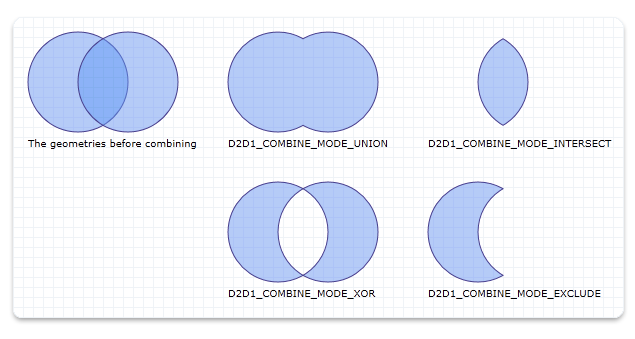Note
Access to this page requires authorization. You can try signing in or changing directories.
Access to this page requires authorization. You can try changing directories.
Combines this geometry with the specified geometry and stores the result in an ID2D1SimplifiedGeometrySink.
Overload list
| Method | Description |
|---|---|
| CombineWithGeometry(ID2D1Geometry*,D2D1_COMBINE_MODE,D2D1_MATRIX_3X2_F&,ID2D1SimplifiedGeometrySink*) | Combines this geometry with the specified geometry and stores the result in an ID2D1SimplifiedGeometrySink. |
| CombineWithGeometry(ID2D1Geometry*,D2D1_COMBINE_MODE,D2D1_MATRIX_3X2_F*,ID2D1SimplifiedGeometrySink*) | Combines this geometry with the specified geometry and stores the result in an ID2D1SimplifiedGeometrySink. |
| CombineWithGeometry(ID2D1Geometry*,D2D1_COMBINE_MODE,D2D1_MATRIX_3X2_F&,FLOAT,ID2D1SimplifiedGeometrySink*) | Combines this geometry with the specified geometry and stores the result in an ID2D1SimplifiedGeometrySink. |
| CombineWithGeometry(ID2D1Geometry*,D2D1_COMBINE_MODE,D2D1_MATRIX_3X2_F*,FLOAT,ID2D1SimplifiedGeometrySink*) | Combines this geometry with the specified geometry and stores the result in an ID2D1SimplifiedGeometrySink. |
Examples
The following code uses each of the different combine modes to combine two ID2D1EllipseGeometry objects.
HRESULT DemoApp::CreateGeometryResources()
{
HRESULT hr = S_OK;
ID2D1GeometrySink *pGeometrySink = NULL;
// Create the first ellipse geometry to merge.
const D2D1_ELLIPSE circle1 = D2D1::Ellipse(
D2D1::Point2F(75.0f, 75.0f),
50.0f,
50.0f
);
hr = m_pD2DFactory->CreateEllipseGeometry(
circle1,
&m_pCircleGeometry1
);
if (SUCCEEDED(hr))
{
// Create the second ellipse geometry to merge.
const D2D1_ELLIPSE circle2 = D2D1::Ellipse(
D2D1::Point2F(125.0f, 75.0f),
50.0f,
50.0f
);
hr = m_pD2DFactory->CreateEllipseGeometry(circle2, &m_pCircleGeometry2);
}
if (SUCCEEDED(hr))
{
//
// Use D2D1_COMBINE_MODE_UNION to combine the geometries.
//
hr = m_pD2DFactory->CreatePathGeometry(&m_pPathGeometryUnion);
if (SUCCEEDED(hr))
{
hr = m_pPathGeometryUnion->Open(&pGeometrySink);
if (SUCCEEDED(hr))
{
hr = m_pCircleGeometry1->CombineWithGeometry(
m_pCircleGeometry2,
D2D1_COMBINE_MODE_UNION,
NULL,
NULL,
pGeometrySink
);
}
if (SUCCEEDED(hr))
{
hr = pGeometrySink->Close();
}
SafeRelease(&pGeometrySink);
}
}
if (SUCCEEDED(hr))
{
//
// Use D2D1_COMBINE_MODE_INTERSECT to combine the geometries.
//
hr = m_pD2DFactory->CreatePathGeometry(&m_pPathGeometryIntersect);
if (SUCCEEDED(hr))
{
hr = m_pPathGeometryIntersect->Open(&pGeometrySink);
if (SUCCEEDED(hr))
{
hr = m_pCircleGeometry1->CombineWithGeometry(
m_pCircleGeometry2,
D2D1_COMBINE_MODE_INTERSECT,
NULL,
NULL,
pGeometrySink
);
}
if (SUCCEEDED(hr))
{
hr = pGeometrySink->Close();
}
SafeRelease(&pGeometrySink);
}
}
if (SUCCEEDED(hr))
{
//
// Use D2D1_COMBINE_MODE_XOR to combine the geometries.
//
hr = m_pD2DFactory->CreatePathGeometry(&m_pPathGeometryXOR);
if (SUCCEEDED(hr))
{
hr = m_pPathGeometryXOR->Open(&pGeometrySink);
if (SUCCEEDED(hr))
{
hr = m_pCircleGeometry1->CombineWithGeometry(
m_pCircleGeometry2,
D2D1_COMBINE_MODE_XOR,
NULL,
NULL,
pGeometrySink
);
}
if (SUCCEEDED(hr))
{
hr = pGeometrySink->Close();
}
SafeRelease(&pGeometrySink);
}
}
if (SUCCEEDED(hr))
{
//
// Use D2D1_COMBINE_MODE_EXCLUDE to combine the geometries.
//
hr = m_pD2DFactory->CreatePathGeometry(&m_pPathGeometryExclude);
if (SUCCEEDED(hr))
{
hr = m_pPathGeometryExclude->Open(&pGeometrySink);
if (SUCCEEDED(hr))
{
hr = m_pCircleGeometry1->CombineWithGeometry(
m_pCircleGeometry2,
D2D1_COMBINE_MODE_EXCLUDE,
NULL,
NULL,
pGeometrySink
);
}
if (SUCCEEDED(hr))
{
hr = pGeometrySink->Close();
}
SafeRelease(&pGeometrySink);
}
}
return hr;
}
This code produces the output shown in the following illustration.

Requirements
| Requirement | Value |
|---|---|
| Library |
|
| DLL |
|